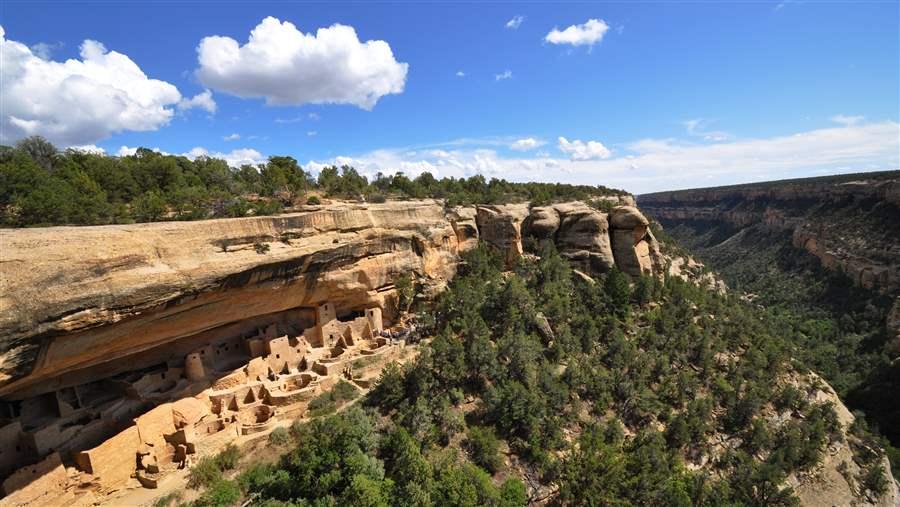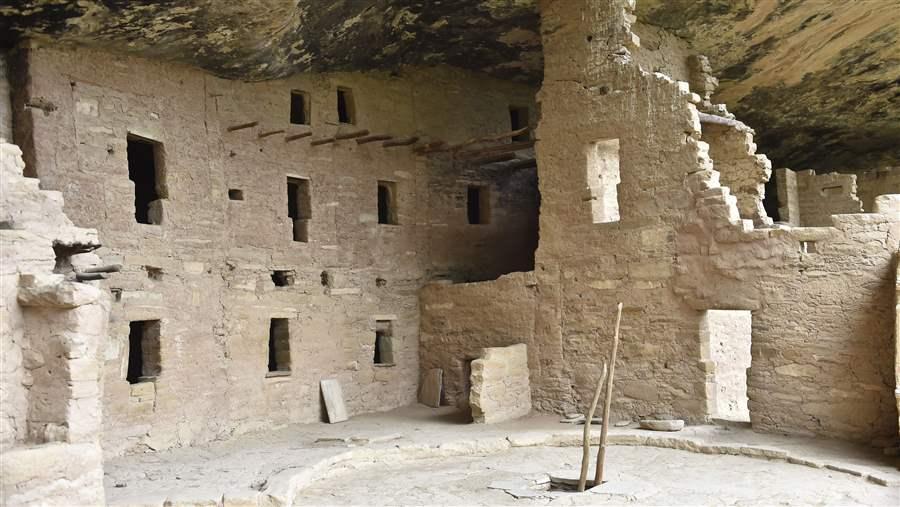Mesa Verde National Park
Colorado

The 52,485-acre park and World Heritage site boasts about 5,000 archaeological sites.
© Robert Alexander/Getty ImagesPew created this case study using National Park Service deferred maintenance data issued in fiscal year 2015. The information listed here may no longer reflect the NPS site’s current condition or maintenance requirements. To find the most up-to-date information, please use the National Park Repair Needs tool.
Overview
Visitors to Mesa Verde National Park can walk among the ruins of cliff dwellings that tell the story of the Pueblo people who lived in this arid landscape from about 600 to 1300. Designated as a national monument by President Theodore Roosevelt in 1906, the 52,485-acre park and World Heritage site boasts about 5,000 archaeological sites.1 Today, more than half a million people visit Mesa Verde annually, and 26 Native American tribes are associated with it. Despite several initiatives to protect the park, its infrastructure, buildings, and many of the largest cliff dwellings need nearly $57 million in deferred maintenance.
Maintenance challenges
Visitors begin their journey into Mesa Verde on a 20-mile winding road into the mountains, with picturesque views of a canyon-dotted landscape from scenic overlooks. Unfortunately, this access road requires frequent repaving, and deferred repairs to it and other roads total $20 million. Large portions of the park are closed to the public, and even those not cordoned off often have limited access due to deferred maintenance. The Spruce Tree House cliff dwelling is the most visited site at Mesa Verde and the most easily accessible, but falling rocks from a sandstone overhang have kept the more than 700-year-old structure closed since October 2015.2 The $6.4 million repair backlog for Mesa Verde’s archaeological sites also includes the 148-room Cliff Palace dwelling, which needs to be stabilized to prevent the ruins from slipping into the canyon.
Buildings throughout the park require maintenance, ranging from repairs to heating and air conditioning systems to upgrades to restroom facilities. Visitors traversing Mesa Verde find a trail network with rehabilitation needs totaling $3.8 million. The water they drink is sent through pipelines that originate in a mountain range 17 miles away—one of the longest water systems in the National Park System. Unfortunately, sections of the pipelines have degraded and need to be replaced, part of $6.4 million in upgrades for the entire system.
Mesa Verde National Park, in my backyard, has deferred projects valued at almost $57 million. It’s time to develop a plan to address this problem before it’s too late and these priceless treasures are lost for future generations.Karen Sheek, mayor, Cortez, Colorado

The park’s nearly $57 million maintenance backlog includes the Spruce Tree House, which is closed because of falling rocks.
© Mladen Antonov/Getty ImagesRecommendations
To address the deferred maintenance needs at Mesa Verde and other National Park Service (NPS) sites in Colorado and across the country, Congress should:
- Ensure that infrastructure initiatives include provisions to address park maintenance.
- Provide dedicated annual federal funding for national park repairs.
- Enact innovative policy reforms to ensure that deferred maintenance does not escalate.
- Provide more highway funding for NPS maintenance needs.
- Create more opportunities for public-private collaboration and donations to help restore park infrastructure.
Mesa Verde National Park Facts
2016
| Visitor spending | $60.6 million |
| Jobs created by visitor spending | 883 |
| Economic output | $73.3 million |
| Labor income | $23.6 million |
| Visits | 583,527 |
| Deferred maintenance (fiscal year 2015) | $56.9 million |
Sources: National Park Service, “Annual Visitation Report by Years: 2006 to 2016,” accessed June 14, 2017, https://irma.nps.gov/Stats/SSRSReports/National%20Reports/Annual%20Visitation%20By%20Park%20(1979%20-%20Last%20Calendar%20Year); National Park Service, “Visitor Spending Effects,” accessed June 14, 2017, https://www.nps.gov/subjects/socialscience/vse.htm; National Park Service, “NPS Deferred Maintenance Reports,” accessed June 23, 2017, https://www.nps.gov/subjects/plandesignconstruct/defermain.htm.
© 2017 The Pew Charitable Trusts
The Pew Charitable Trusts works alongside the National Parks Conservation Association, the National Trust for Historic Preservation, and other national and local groups to ensure that our national park resources are maintained and protected for future generations to enjoy.
Endnotes
- National Park Service, “Mesa Verde National Park,” accessed Jan. 15, 2017, https://www.nps.gov/meve/index.htm.
- Deb Stanley, “Mesa Verde National Park’s Most Visited Dwelling, Spruce Tree House, Remains Closed Due to Rock Fall,” Feb. 23, 2016, http://www.thedenverchannel.com/news/southwestern-colorado/mesa-verde-national-parks-most-visited-dwelling-spruce-tree-houseremains-closed-due-to-rock-fall.














